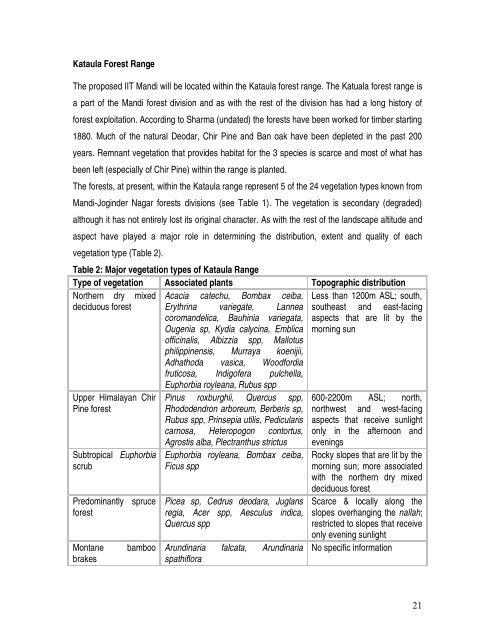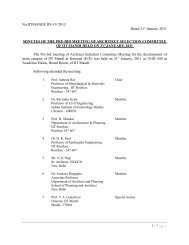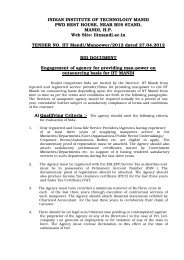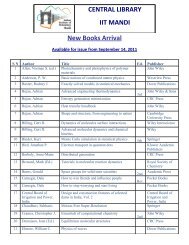Eco Report of the area - IIT Mandi
Eco Report of the area - IIT Mandi
Eco Report of the area - IIT Mandi
Create successful ePaper yourself
Turn your PDF publications into a flip-book with our unique Google optimized e-Paper software.
Kataula Forest Range<br />
The proposed <strong>IIT</strong> <strong>Mandi</strong> will be located within <strong>the</strong> Kataula forest range. The Katuala forest range is<br />
a part <strong>of</strong> <strong>the</strong> <strong>Mandi</strong> forest division and as with <strong>the</strong> rest <strong>of</strong> <strong>the</strong> division has had a long history <strong>of</strong><br />
forest exploitation. According to Sharma (undated) <strong>the</strong> forests have been worked for timber starting<br />
1880. Much <strong>of</strong> <strong>the</strong> natural Deodar, Chir Pine and Ban oak have been depleted in <strong>the</strong> past 200<br />
years. Remnant vegetation that provides habitat for <strong>the</strong> 3 species is scarce and most <strong>of</strong> what has<br />
been left (especially <strong>of</strong> Chir Pine) within <strong>the</strong> range is planted.<br />
The forests, at present, within <strong>the</strong> Kataula range represent 5 <strong>of</strong> <strong>the</strong> 24 vegetation types known from<br />
<strong>Mandi</strong>-Joginder Nagar forests divisions (see Table 1). The vegetation is secondary (degraded)<br />
although it has not entirely lost its original character. As with <strong>the</strong> rest <strong>of</strong> <strong>the</strong> landscape altitude and<br />
aspect have played a major role in determining <strong>the</strong> distribution, extent and quality <strong>of</strong> each<br />
vegetation type (Table 2).<br />
Table 2: Major vegetation types <strong>of</strong> Kataula Range<br />
Type <strong>of</strong> vegetation Associated plants Topographic distribution<br />
Nor<strong>the</strong>rn dry mixed<br />
deciduous forest<br />
Upper Himalayan Chir<br />
Pine forest<br />
Subtropical Euphorbia<br />
scrub<br />
Predominantly spruce<br />
forest<br />
Montane<br />
brakes<br />
bamboo<br />
Acacia catechu, Bombax ceiba,<br />
Erythrina variegate, Lannea<br />
coromandelica, Bauhinia variegata,<br />
Ougenia sp, Kydia calycina, Emblica<br />
<strong>of</strong>ficinalis, Albizzia spp, Mallotus<br />
philippinensis, Murraya koenijii,<br />
Adhathoda vasica, Woodfordia<br />
fruticosa, Indig<strong>of</strong>era pulchella,<br />
Euphorbia royleana, Rubus spp<br />
Pinus roxburghii, Quercus spp,<br />
Rhododendron arboreum, Berberis sp,<br />
Rubus spp, Prinsepia utilis, Pedicularis<br />
carnosa, Heteropogon contortus,<br />
Agrostis alba, Plectranthus strictus<br />
Euphorbia royleana, Bombax ceiba,<br />
Ficus spp<br />
Picea sp, Cedrus deodara, Juglans<br />
regia, Acer spp, Aesculus indica,<br />
Quercus spp<br />
Arundinaria falcata, Arundinaria<br />
spathiflora<br />
Less than 1200m ASL; south,<br />
sou<strong>the</strong>ast and east-facing<br />
aspects that are lit by <strong>the</strong><br />
morning sun<br />
600-2200m ASL; north,<br />
northwest and west-facing<br />
aspects that receive sunlight<br />
only in <strong>the</strong> afternoon and<br />
evenings<br />
Rocky slopes that are lit by <strong>the</strong><br />
morning sun; more associated<br />
with <strong>the</strong> nor<strong>the</strong>rn dry mixed<br />
deciduous forest<br />
Scarce & locally along <strong>the</strong><br />
slopes overhanging <strong>the</strong> nallah;<br />
restricted to slopes that receive<br />
only evening sunlight<br />
No specific information<br />
21
















